Retrieval of Carbon Dioxide Using Cross-Track Infrared Sounder (CrIS) on S-NPP
Abstract
1. Introduction
2. Data
2.1. CrIS Instrument and Its Products
2.2. Validation Data
3. Method
3.1. The Sensitivity of CrIS Channels to CO2
3.2. Physical Retrieval Method
4. Results
4.1. Comparison with CARIBIC
4.2. Comparison with TCCON
4.3. Spatial Distribution of CO2
4.4. Uncertainty Analysis
5. Discussion
6. Conclusions
Author Contributions
Funding
Institutional Review Board Statement
Informed Consent Statement
Data Availability Statement
Acknowledgments
Conflicts of Interest
References
- Umezawa, T.; Matsueda, H.; Sawa, Y.; Niwa, Y.; Machida, T.; Zhou, L. Seasonal evaluation of tropospheric CO2 over the Asia-Pacific region observed by the CONTRAIL commercial airliner measurements. Atmos. Chem. Phys. Discuss. 2018, 18, 14851–14866. [Google Scholar] [CrossRef]
- Pearce, W.; Holmberg, K.; Hellsten, I.; Nerlich, B. Climate Change on Twitter: Topics, Communities and Conversations about the 2013 IPCC Working Group 1 Report. PLoS ONE 2014, 9, e94785. [Google Scholar] [CrossRef]
- WMO. Wdcgg Data Summary; Japan Meteorological Agency in Co-Operation with World Meteoro-Logical Organization; WMO: Geneva, Switzerland, 2018.
- Stocker, F.T.; Qin, D.; Plattner, G.-K.; Tignor, M.; Allen, S.K.; Boschung, J.; Nauels, A.; Xia, Y.; Bex, V.; Midgley, P.M. IPCC, 2013: The Physical Science Basis. Contribution of Working Group I to the Fifth Assessment Report of the Intergovernmental Panel on Climate Change; Cambridge University Press: Cambridge, UK, 2013; p. 1535. [Google Scholar]
- Park, H.; Takeuchi, W.; Ichii, K. Satellite-Based Estimation of Carbon Dioxide Budget in Tropical Peatland Ecosystems. Remote. Sens. 2020, 12, 250. [Google Scholar] [CrossRef]
- Diao, A.; Shu, J.; Song, C.; Gao, W. Global consistency check of AIRS and IASI total CO2 column concentrations using WDCGG ground-based measurements. Front. Earth Sci. 2017, 11, 1–10. [Google Scholar] [CrossRef]
- Brenninkmeijer, C.A.M.; Crutzen, P.; Boumard, F.; Dauer, T.; Dix, B.; Ebinghaus, R.; Filippi, D.; Fischer, H.; Franke, H.; Frieβ, U.; et al. Civil Aircraft for the regular investigation of the atmosphere based on an instrumented container: The new CARIBIC system. Atmos. Chem. Phys. Discuss. 2007, 7, 4953–4976. [Google Scholar] [CrossRef]
- Wunch, D.; Toon, G.C.; Wennberg, P.O.; Wofsy, S.C.; Stephens, B.B.; Fischer, M.L.; Uchino, O.; Abshire, J.B.; Bernath, P.F.; Biraud, S.; et al. Calibration of the Total Carbon Column Observing Network using aircraft profile data. Atmos. Meas. Tech. 2010, 3, 1351–1362. [Google Scholar] [CrossRef]
- Houweling, S.; Hartmann, W.; Aben, I.; Schrijver, H.; Skidmore, J.; Roelofs, G.-J.; Breon, F.-M. Evidence of systematic errors in SCIAMACHY-observed CO2 due to aerosols. Atmos. Chem. Phys. Discuss. 2005, 5, 3003–3013. [Google Scholar] [CrossRef]
- Chevallier, F.; Engelen, R.J.; Peylin, P. The contribution of AIRS data to the estimation of CO2sources and sinks. Geophys. Res. Lett. 2005, 32. [Google Scholar] [CrossRef]
- Baker, D.F.; Bösch, H.; Doney, S.C.; O’Brien, D.; Schimel, D.S. Carbon source/sink information provided by column CO2 measurements from the Orbiting Carbon Observatory. Atmos. Chem. Phys. Discuss. 2010, 10, 4145–4165. [Google Scholar] [CrossRef]
- Chevallier, F.; Bréon, F.-M.; Rayner, P.J. Contribution of the Orbiting Carbon Observatory to the estimation of CO2sources and sinks: Theoretical study in a variational data assimilation framework. J. Geophys. Res. Space Phys. 2007, 112. [Google Scholar] [CrossRef]
- Nassar, R.; Logan, J.A.; Worden, H.M.; Megretskaia, I.A.; Bowman, K.W.; Osterman, G.B.; Thompson, A.M.; Tarasick, D.W.; Austin, S.; Claude, H.; et al. Validation of Tropospheric Emission Spectrometer (TES) nadir ozone profiles using ozonesonde measurements. J. Geophys. Res. Space Phys. 2008, 113. [Google Scholar] [CrossRef]
- Lei, L.; Guan, X.; Zeng, Z.; Zhang, B.; Ru, F.; Bu, R. A comparison of atmospheric CO2 concentration GOSAT-based observations and model simulations. Sci. China Earth Sci. 2014, 57, 1393–1402. [Google Scholar] [CrossRef]
- Crevoisier, C.; Heilliette, S.; Chédin, A.; Serrar, S.; Armante, R.; Scott, N.A. Midtropospheric CO2concentration retrieval from AIRS observations in the tropics. Geophys. Res. Lett. 2004, 31. [Google Scholar] [CrossRef]
- Ebojie, F.; Burrows, J.P.; Gebhardt, C.; Ladstätter-Weißenmayer, A.; Von Savigny, C.; Rozanov, A.; Weber, M.; Bovensmann, H. Global tropospheric ozone variations from 2003 to 2011 as seen by SCIAMACHY. Atmos. Chem. Phys. Discuss. 2016, 16, 417–436. [Google Scholar] [CrossRef]
- Reuter, M.; Bovensmann, H.; Buchwitz, M.; Burrows, J.P.; Connor, B.J.; Deutscher, N.M.; Griffith, D.W.T.; Heymann, J.; Keppel-Aleks, G.; Messerschmidt, J.; et al. Retrieval of atmospheric CO2with enhanced accuracy and precision from SCIAMACHY: Validation with FTS measurements and comparison with model results. J. Geophys. Res. Space Phys. 2011, 116. [Google Scholar] [CrossRef]
- Crevoisier, C.; Nobileau, D.; Armante, R.; Crépeau, L.; Machida, T.; Sawa, Y.; Matsueda, H.; Schuck, T.; Thonat, T.; Pernin, J.; et al. The 2007–2011 evolution of tropical methane in the mid-troposphere as seen from space by MetOp-A/IASI. Atmos. Chem. Phys. Discuss. 2013, 13, 4279–4289. [Google Scholar] [CrossRef]
- Fu, D.; Bowman, K.W.; Worden, H.M.; Natraj, V.; Worden, J.R.; Yu, S.; Veefkind, P.; Aben, I.; Landgraf, J.; Strow, L.; et al. High-resolution tropospheric carbon monoxide profiles retrieved from CrIS and TROPOMI. Atmos. Meas. Tech. 2016, 9, 2567–2579. [Google Scholar] [CrossRef]
- Wu, C.; Qi, C.; Hu, X.; Gu, M.; Yang, T.; Xu, H.; Lee, L.; Yang, Z.; Zhang, P. FY-3D HIRAS Radiometric Calibration and Accuracy Assessment. IEEE Trans. Geosci. Remote. Sens. 2020, 58, 3965–3976. [Google Scholar] [CrossRef]
- Kulawik, S.S.; Jones, D.B.A.; Nassar, R.; Irion, F.W.; Worden, J.R.; Bowman, K.W.; Machida, T.; Matsueda, H.; Sawa, Y.; Biraud, S.C.; et al. Characterization of Tropospheric Emission Spectrometer (TES) CO2 for carbon cycle science. Atmos. Chem. Phys. Discuss. 2010, 10, 5601–5623. [Google Scholar] [CrossRef]
- Baker, D.F.; Doney, S.C.; Schimel, D.S. Variational data assimilation for atmospheric CO2. Tellus B: Chem. Phys. Meteorol. 2006, 58, 359–365. [Google Scholar] [CrossRef]
- Chahine, M.T.; Chen, L.; Dimotakis, P.; Jiang, X.; Li, Q.; Olsen, E.T.; Pagano, T.; Randerson, J.; Yung, Y.L. Satellite remote sounding of mid-tropospheric CO2. Geophys. Res. Lett. 2008, 35. [Google Scholar] [CrossRef]
- Wang, T.; Shi, J.; Jing, Y.; Xie, Y. Investigation of the consistency of atmospheric CO2 retrievals from different space-based sensors: Intercomparison and spatiotemporal analysis. Chin. Sci. Bull. 2013, 58, 4161–4170. [Google Scholar] [CrossRef]
- Thonat, T.; Crevoisier, C.; Scott, N.A.; Chédin, A.; Schuck, T.; Armante, R.; Crépeau, L. Retrieval of tropospheric CO column from hyperspectral infrared sounders—Application to four years of Aqua/AIRS and MetOp-A/IASI. Atmos. Meas. Tech. 2012, 5, 2413–2429. [Google Scholar] [CrossRef]
- Crevoisier, C.; Chedin, A.; Matsueda, H.; Machida, T.; Armante, R.; Scott, N.A. First year of upper tropospheric integrated content of CO2 from IASI hyperspectral infrared observations. Atmos. Chem. Phys. Discuss. 2009, 9, 4797–4810. [Google Scholar] [CrossRef]
- Wunch, D.; Wennberg, P.O.; Osterman, G.; Fisher, B.; Naylor, B.; Roehl, C.M.; O’Dell, C.; Mandrake, L.; Viatte, C.; Kiel, M.; et al. Comparisons of the Orbiting Carbon Observatory-2 (OCO-2) XCO2 measurements with TCCON. Atmos. Meas. Tech. 2017, 10, 2209–2238. [Google Scholar] [CrossRef]
- Lin, L.; Zou, X.; Weng, F. Combining CrIS double CO 2 bands for detecting clouds located in different layers of the atmosphere. J. Geophys. Res. Atmos. 2017, 122, 1811–1827. [Google Scholar] [CrossRef]
- Yi, B.; Ding, S.; Bi, L. Impacts of cloud scattering properties on FY-3D HIRAS simulations. J. Quant. Spectrosc. Radiat. Transf. 2020, 246, 106902. [Google Scholar] [CrossRef]
- O’Dell, C.W.; Connor, B.; Bösch, H.; O’Brien, D.; Frankenberg, C.; Castano, R.; Christi, M.; Eldering, D.; Fisher, B.; Gunson, M.; et al. The ACOS CO2 retrieval algorithm—Part 1: Description and validation against synthetic observations. Atmos. Meas. Tech. 2012, 5, 99–121. [Google Scholar] [CrossRef]
- Connor, B.J.; Boesch, H.; Toon, G.; Sen, B.; Miller, C.; Crisp, D. Orbiting Carbon Observatory: Inverse method and prospective error analysis. J. Geophys. Res. Space Phys. 2008, 113. [Google Scholar] [CrossRef]
- Reuter, M.; Buchwitz, M.; Schneising, O.; Heymann, J.; Bovensmann, H.; Burrows, J.P. A method for improved SCIAMACHY CO2 retrieval in the presence of optically thin clouds. Atmos. Meas. Tech. 2010, 3, 209–232. [Google Scholar] [CrossRef]
- Ma, P.; Chen, L.; Wang, Z.; Zhao, S.; Li, Q.; Tao, M.; Wang, Z. Ozone Profile Retrievals from the Cross-Track Infrared Sounder. IEEE Trans. Geosci. Remote. Sens. 2016, 54, 3985–3994. [Google Scholar] [CrossRef]
- Nalli, N.R.; Gambacorta, A.; Liu, Q.; Tan, C.; Iturbide-Sanchez, F.; Barnet, C.D.; Joseph, E.; Morris, V.R.; Oyola, M.; Smith, J.W. Validation of Atomospheric Profile Retrieval from the SNPP NOAA-Unique Combimed Atmospheric Processing System. Part 2: Ozone. IEEE Trans. Geosci. Romote Sens. 2018, 56, 598–607. [Google Scholar] [CrossRef]
- Nalli, N.R.; Gambacorta, A.; Liu, Q.; Barnet, C.D.; Tan, C.; Iturbide-Sanchez, F.; Reale, T.; Sun, B.; Wilson, M.; Borg, L.; et al. Validation of Atmospheric Profile Retrievals From the SNPP NOAA-Unique Combined Atmospheric Processing System. Part 1: Temperature and Moisture. IEEE Trans. Geosci. Remote. Sens. 2017, 56, 180–190. [Google Scholar] [CrossRef]
- Wang, P.; Li, J.; Li, Z.; Lim, A.H.N.; Li, J.; Schmit, T.J.; Goldberg, M.D. The Impact of Cross-track Infrared Sounder (CrIS) Cloud-Cleared Radiances on Hurricane Joaquin (2015) and Matthew (2016) Forecasts. J. Geophys. Res. Atmos. 2017, 122, 13–201. [Google Scholar] [CrossRef]
- Susskind, J.; Barnet, C.D.; Blaisdell, J.M. Retrieval of atmospheric and surface parameters from AIRS/AMSU/HSB data in the presence of clouds. IEEE Trans. Geosci. Remote Sens. 2003, 41, 390–409. [Google Scholar] [CrossRef]
- Susskind, J.; Blaisdell, J.M.; Iredell, L.; Keita, F. Improved Temperature Sounding and Quality Control Methodology Using AIRS/AMSU Data: The AIRS Science Team Version 5 Retrieval Algorithm. IEEE Trans. Geosci. Remote. Sens. 2011, 49, 883–907. [Google Scholar] [CrossRef]
- Smith, N.; Barnet, C.D. Uncertainty Characterization and Propagation in the Community Long-Term Infrared Microwave Combined Atmospheric Product System (CLIMCAPS). Remote. Sens. 2019, 11, 1227. [Google Scholar] [CrossRef]
- Smith, N.; Barnet, C.D. CLIMCAPS observing capability for temperature, moisture, and trace gases from AIRS/AMSU and CrIS/ATMS. Atmos. Meas. Tech. 2020, 13, 4437–4459. [Google Scholar] [CrossRef]
- Gambacorta, N.R.N.A.; Barnet, C.D.; Tan, C.; Iturbide-Sanchez, F.; Zhang, K.; The NOAA Unique Combined Atmospheric Processing System (NUCAPS) Algorithm Theoretical Basis Document. NOAA, Ed.; 2017. Available online: https://www.star.nesdis.noaa.gov/jpss/documents/ATBD/ATBD_NUCAPS_v2.0.pdf (accessed on 14 August 2017).
- Schuck, T.J.; Brenninkmeijer, C.A.M.; Baker, A.K.; Šlemr, F.; Von Velthoven, P.F.J.; Zahn, A. Greenhouse gas relationships in the Indian summer monsoon plume measured by the CARIBIC passenger aircraft. Atmos. Chem. Phys. Discuss. 2010, 10, 3965–3984. [Google Scholar] [CrossRef]
- Baker, A.K.; Slemr, F.; Brenninkmeijer, C.A.M. Analysis of non-methane hydrocarbons in air samples collected aboard the CARIBIC passenger aircraft. Atmos. Meas. Tech. 2010, 3, 311–321. [Google Scholar] [CrossRef]
- Assonov, S.S.; Brenninkmeijer, C.A.M.; Schuck, T.J.; Taylor, P. Analysis of 13C and 18O isotope data of CO2 in CARIBIC aircraft samples as tracers of upper troposphere/lower stratosphere mixing and the global carbon cycle. Atmos. Chem. Phys. Discuss. 2010, 10, 8575–8599. [Google Scholar] [CrossRef]
- Messerschmidt, J.; Geibel, M.C.; Blumenstock, T.; Chen, H.; Deutscher, N.M.; Engel, A.; Feist, D.G.; Gerbig, C.; Gisi, M.; Hase, F.; et al. Calibration of TCCON column-averaged CO2: The first aircraft campaign over European TCCON sites. Atmos. Chem. Phys. Discuss. 2011, 11, 10765–10777. [Google Scholar] [CrossRef]
- Blumenstock, T.; Hase, F.; Schneider, M.; García, O.E.; Sepúlveda, E. TCCON Data from Izana (ES), Release GGG2014.R1 (Version R1), TCCON Data Archive, Hosted by CaltechDATA. 2007. Available online: https://doi.org/10.14291/TCCON.GGG2014.IZANA01.R1 (accessed on 20 January 2020).
- Wennberg, P.O.; Wunch, D.; Roehl, C.M.; Blavier, J.-F.; Toon, G.C.; Allen, N.T. TCCON Data from Caltech (US), Release GGG2014.R1 (Version GGG2014.R1), TCCON Data Archive, Hosted by CaltechDATA. 2015. Available online: https://doi.org/10.14291/TCCON.GGG2014.PASADENA01.R1/1182415 (accessed on 20 January 2020).
- Iraci, L.T.; Podolske, J.R.; Hillyard, P.W.; Roehl, C.; Wennberg, P.O.; Blavier, J.-F.; Landeros, J.; Allen, N.; Wunch, D.; Zavaleta, J.; et al. TCCON Data from Edwards (US), Release GGG2014.R1 (Version GGG2014.R1), TCCON Data Archive, Hosted by CaltechDATA. 2016. Available online: https://doi.org/10.14291/TCCON.GGG2014.EDWARDS01.R1/1255068 (accessed on 20 January 2020).
- Wennberg, P.O.; Wunch, D.; Roehl, C.M.; Blavier, J.-F.; Toon, G.C.; Allen, N.T. TCCON Data from Lamont (US), Release GGG2014.R1 (Version GGG2014.R1), TCCON Data Archive, Hosted by CaltechDATA. 2016. Available online: https://doi.org/10.14291/TCCON.GGG2014.LAMONT01.R1/1255070 (accessed on 20 January 2020).
- Wennberg, P.O.; Roehl, C.M.; Wunch, D.; Toon, G.C.; Blavier, J.-F.; Washenfelder, R.; Keppel-Aleks, G.; Allen, N.T.; Ayers, J. TCCON data from Park Falls (US), Release GGG2014.R1 (Version GGG2014.R1), TCCON Data Archive, Hosted by CaltechDATA. 2017. Available online: https://doi.org/10.14291/TCCON.GGG2014.PARKFALLS01.R1 (accessed on 20 January 2020).
- Sussmann, R.; Rettinger, M. TCCON Data from Garmisch (DE), Release GGG2014.R2 (Version R2), TCCON Data Archive, Hosted by CaltechDATA. 2018. Available online: https://doi.org/10.14291/TCCON.GGG2014.GARMISCH01.R2 (accessed on 20 January 2020).
- Hase, F.; Blumenstock, T.; Dohe, S.; Groß, J.; Kiel, M. TCCON Data from Karlsruhe (DE), Release GGG2014.R1 (Version GGG2014.R1), TCCON Data Archive, Hosted by CaltechDATA. 2015. Available online: https://doi.org/10.14291/TCCON.GGG2014.KARLSRUHE01.R1/1182416 (accessed on 20 January 2020).
- Wunch, D.; Mendonca, J.; Colebatch, O.; Allen, N.T.; Blavier, J.-F.; Roche, S.; Hedelius, J.; Neufeld, G.; Springett, S.; Worthy, D.; et al. TCCON Data from East Trout Lake, SK (CA), Release GGG2014.R1 (Version R1), TCCON Data Archive, Hosted by CaltechDATA. 2018. Available online: https://doi.org/10.14291/TCCON.GGG2014.EASTTROUTLAKE01.R1 (accessed on 20 January 2020).
- Chevallier, F.; Chéruy, F.; Scott, N.A.; Chédin, A. A Neural Network Approach for a Fast and Accurate Computation of a Longwave Radiative Budget. J. Appl. Meteorol. 1998, 37, 1385–1397. [Google Scholar] [CrossRef]
- Strow, L.; Hannon, S.; De Souza-Machado, S.; Motteler, H.; Tobin, D. An overview of the AIRS radiative transfer model. IEEE Trans. Geosci. Remote. Sens. 2003, 41, 303–313. [Google Scholar] [CrossRef]
- Zhang, Y.; Xiong, X.; Tao, J.; Yu, C.; Zou, M.; Su, L.; Chen, L. Methane retrieval from Atmospheric Infrared Sounder using EOF-based regression algorithm and its validation. Chin. Sci. Bull. 2014, 59, 1508–1518. [Google Scholar] [CrossRef]
- Marco, M. The Generation of RTTOV Regression Coefficients for IASI and Airs Using a New Profile Training Set and a New Line-by-Line Database; ECMWF Technical Memoranda. ECMWF: Reading, UK, 2008; Available online: https://www.ecmwf.int/node/11040 (accessed on 26 January 2021).
- Zhang, Y.; Tao, J.H.; Su, L.; Yu, C.; Fan, M. Retrieval of methane profiles from spaceborne hyperspectral infrared observations. J. Remote Sens. 2012, 16, 232–247. [Google Scholar]
- Xiong, X.; Han, Y.; Liu, Q.; Weng, F. Comparison of Atmospheric Methane Retrievals From AIRS and IASI. IEEE J. Sel. Top. Appl. Earth Obs. Remote. Sens. 2016, 9, 3297–3303. [Google Scholar] [CrossRef]
- Xiong, X.; Barnet, C.; Maddy, E.; Sweeney, C.; Liu, X.; Zhou, L.; Goldberg, M. Characterization and validation of methane products from the Atmospheric Infrared Sounder (AIRS). J. Geophys. Res. Space Phys. 2008, 113. [Google Scholar] [CrossRef]
- Rodgers, C.D.; Connor, B.J. Intercomparison of remote sounding instruments. J. Geophys. Res. Space Phys. 2003, 108. [Google Scholar] [CrossRef]
- Inoue, M.; Morino, I.; Uchino, O.; Miyamoto, Y.; Yoshida, Y.; Yokota, T.; Machida, T.; Sawa, Y.; Matsueda, H.; Sweeney, C.; et al. Validation of XCO2 derived from SWIR spectra of GOSAT TANSO-FTS with aircraft measurement data. Atmos. Chem. Phys. Discuss. 2013, 13, 9771–9788. [Google Scholar] [CrossRef]
- McMillan, W.W.; Barnet, C.; Strow, L.; Chahine, M.T.; McCourt, M.L.; Warner, J.X.; Novelli, P.C.; Korontzi, S.; Maddy, E.S.; Datta, S. Daily global maps of carbon monoxide from NASA’s Atmospheric Infrared Sounder. Geophys. Res. Lett. 2005, 32, L11801. [Google Scholar] [CrossRef]
- Ch’edin, A.; Serrar, S.; Scott, N.A.; Crevoisier, C.; Armante, R. First global measurement of mid-tropospheric CO2 from NOAA polar satellites: Tropical zone. J. Geophys. Res. 2003, 108, 4581. [Google Scholar] [CrossRef]
- Hoskins, B.J.; Hodges, K.I. A New Perspective on Southern Hemisphere Storm Tracks. J. Clim. 2005, 18, 4108–4129. [Google Scholar] [CrossRef]
- Deutscher, N.M.; Sherlock, V.; Fletcher, S.E.M.; Griffith, D.W.T.; Notholt, J.; Macatangay, R.; Connor, B.J.; Robinson, J.; Shiona, H.; Velazco, V.A.; et al. Drivers of column-average CO2 variability at Southern Hemispheric Total Carbon Column Observing Network sites. Atmos. Chem. Phys. Discuss. 2014, 14, 9883–9901. [Google Scholar] [CrossRef]
- Stohl, A.; Eckhardt, S.; Forster, C.; James, P.; Spichtinger, N. On the pathways and timescales of intercontinental air pollution transport. J. Geophys. Res. Space Phys. 2002, 107, 1–17. [Google Scholar] [CrossRef]
- Shim, C.; Lee, J.; Wang, Y. Effect of continental sources and sinks on the seasonal and latitudinal gradient of atmospheric carbon dioxide over East Asia. Atmos. Environ. 2013, 79, 853–860. [Google Scholar] [CrossRef]
- Liang, Q.; Jaeglé, L.; Jaffe, D.A.; Weiss-Penzias, P.; Heckman, A.; Snow, J.A. Long-range transport of Asian pollution to the northeast Pacific: Seasonal variations and transport pathways of carbon monoxide. J. Geophys. Res. Space Phys. 2004, 109, 1–18. [Google Scholar] [CrossRef]
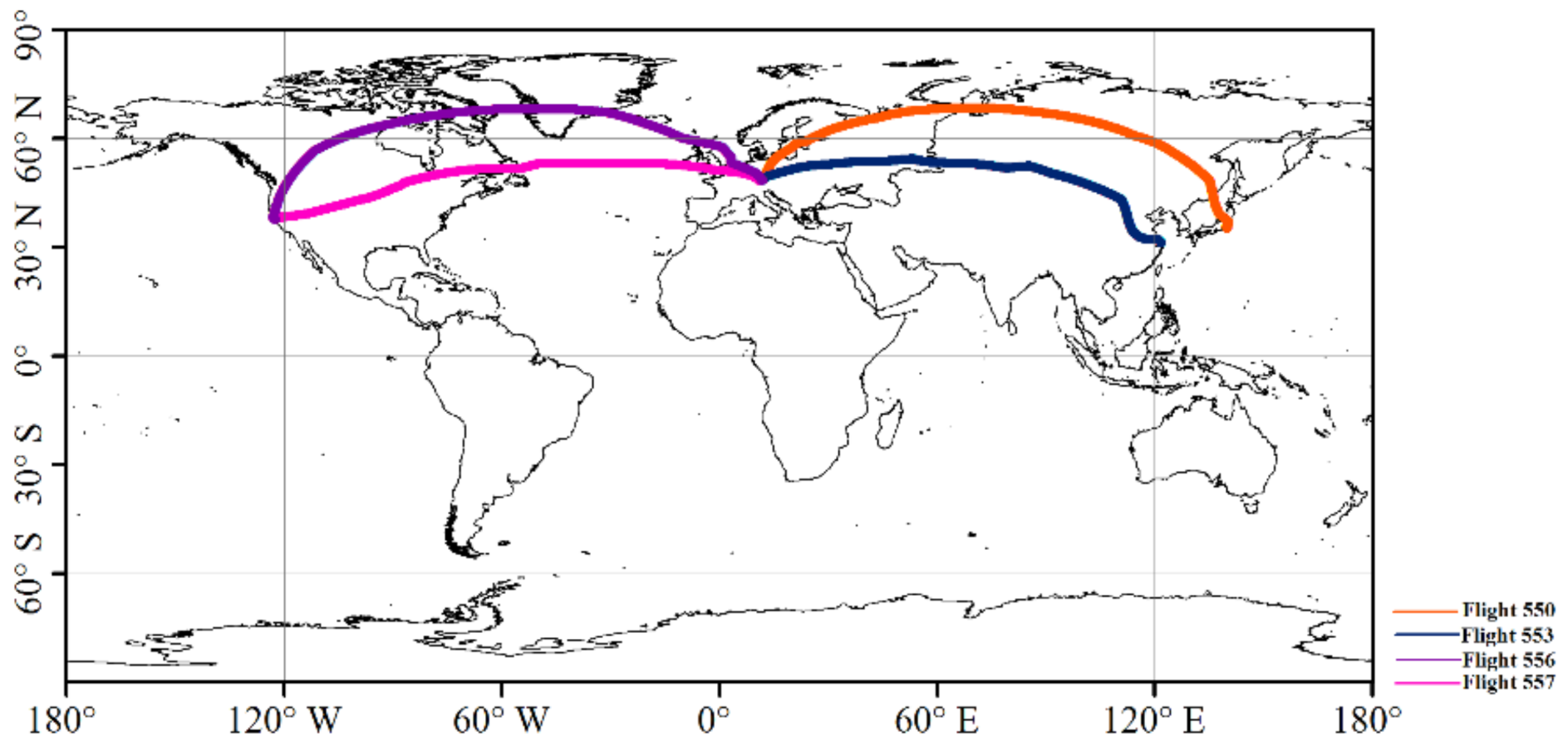
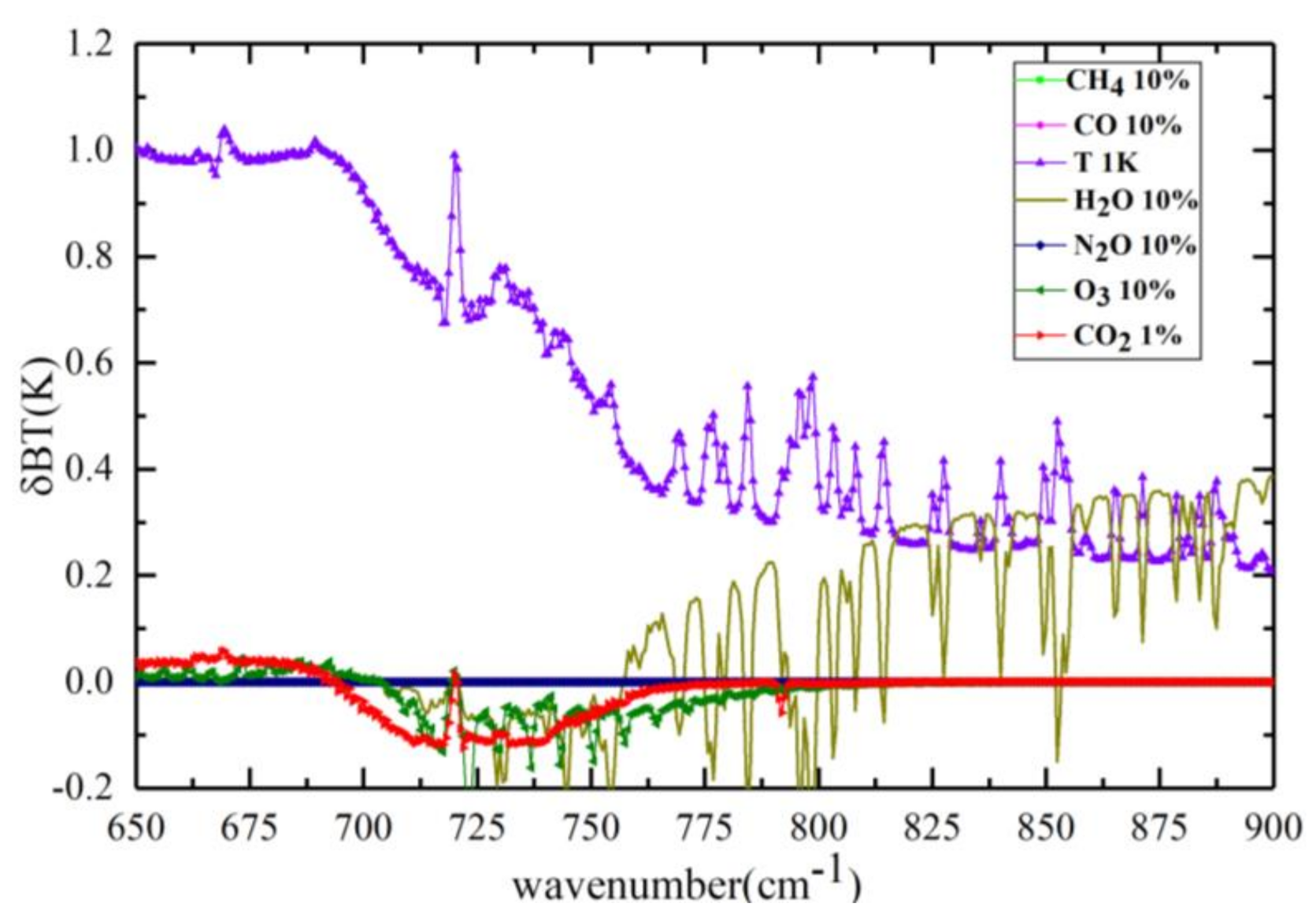
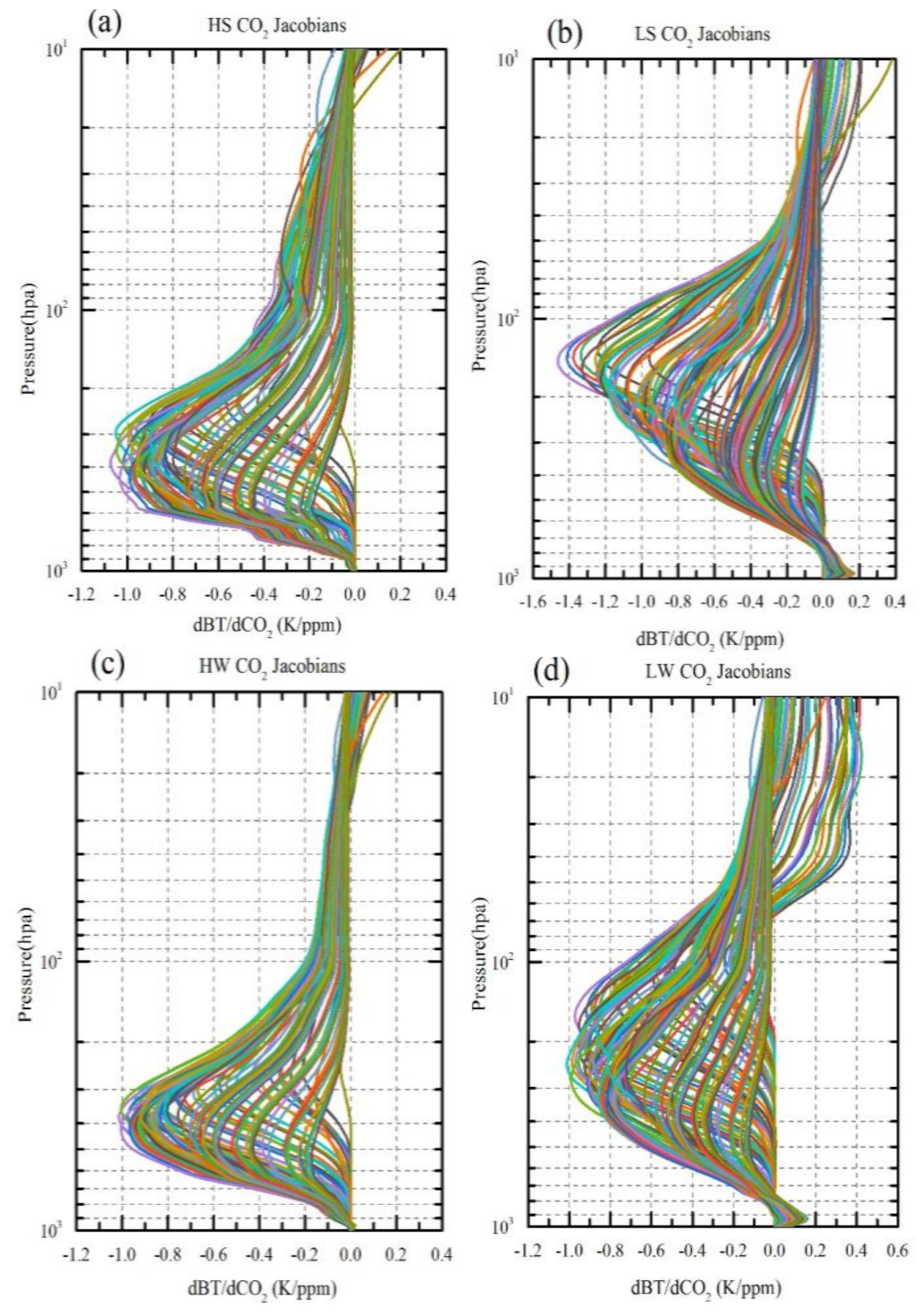
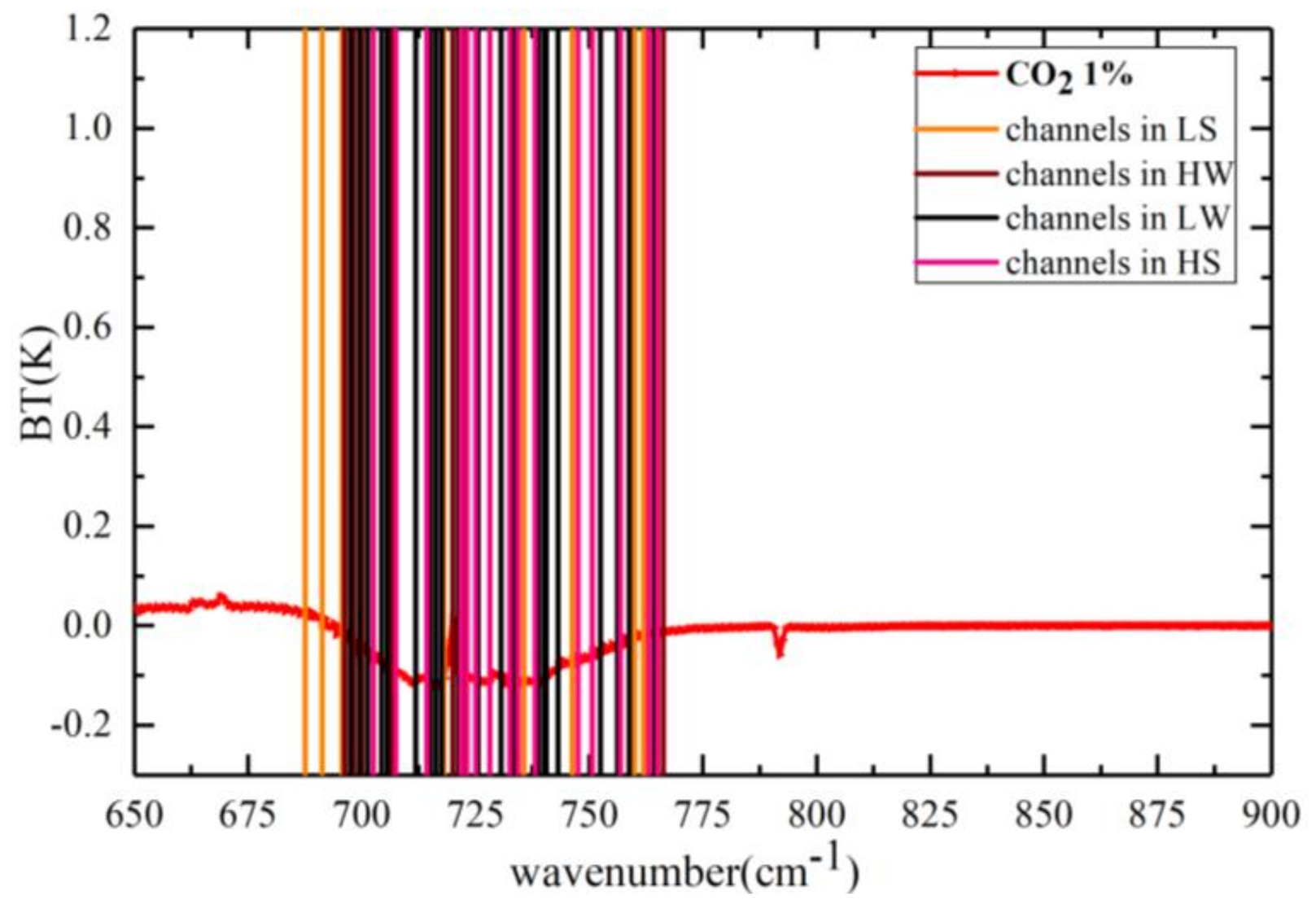

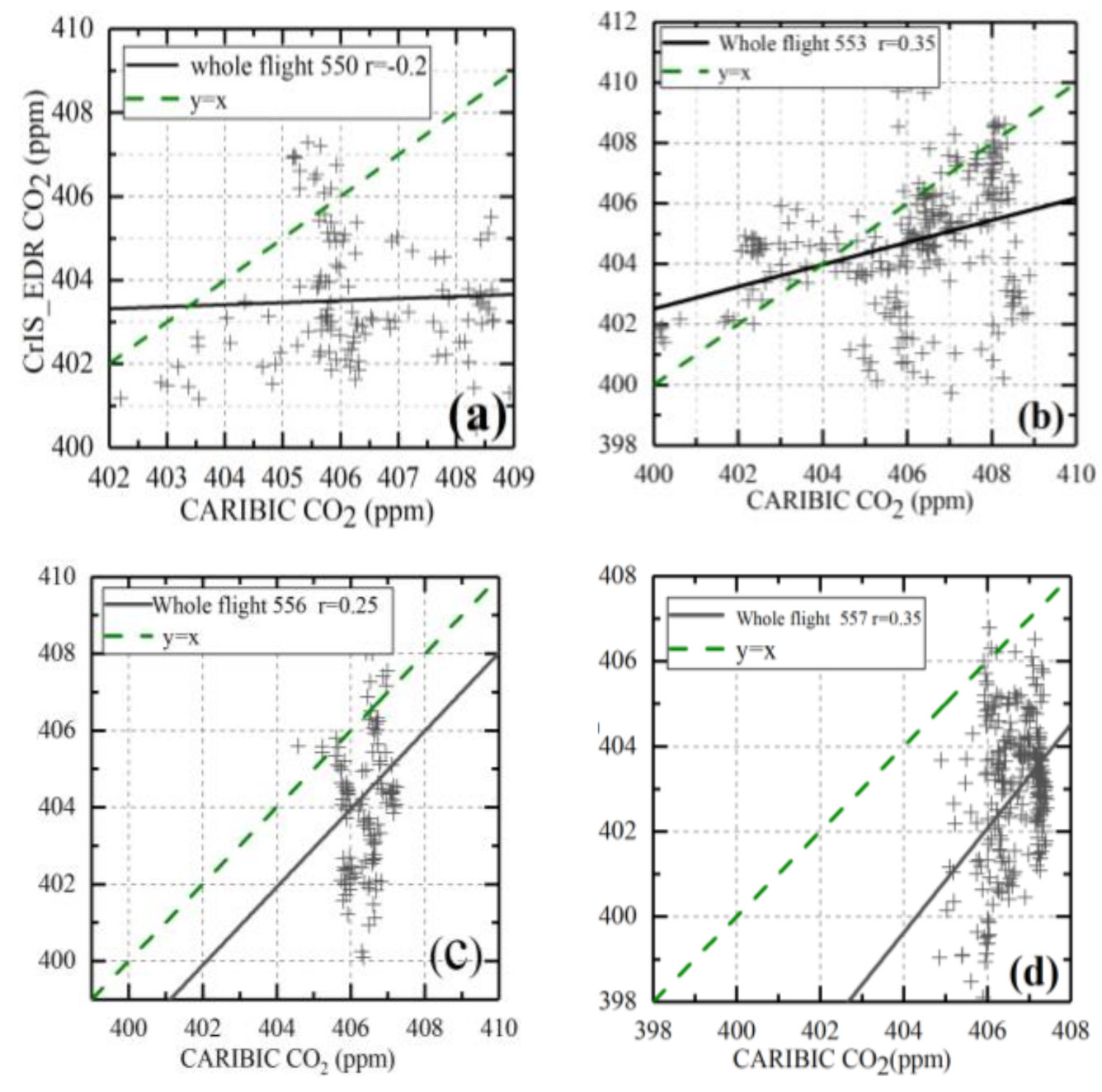

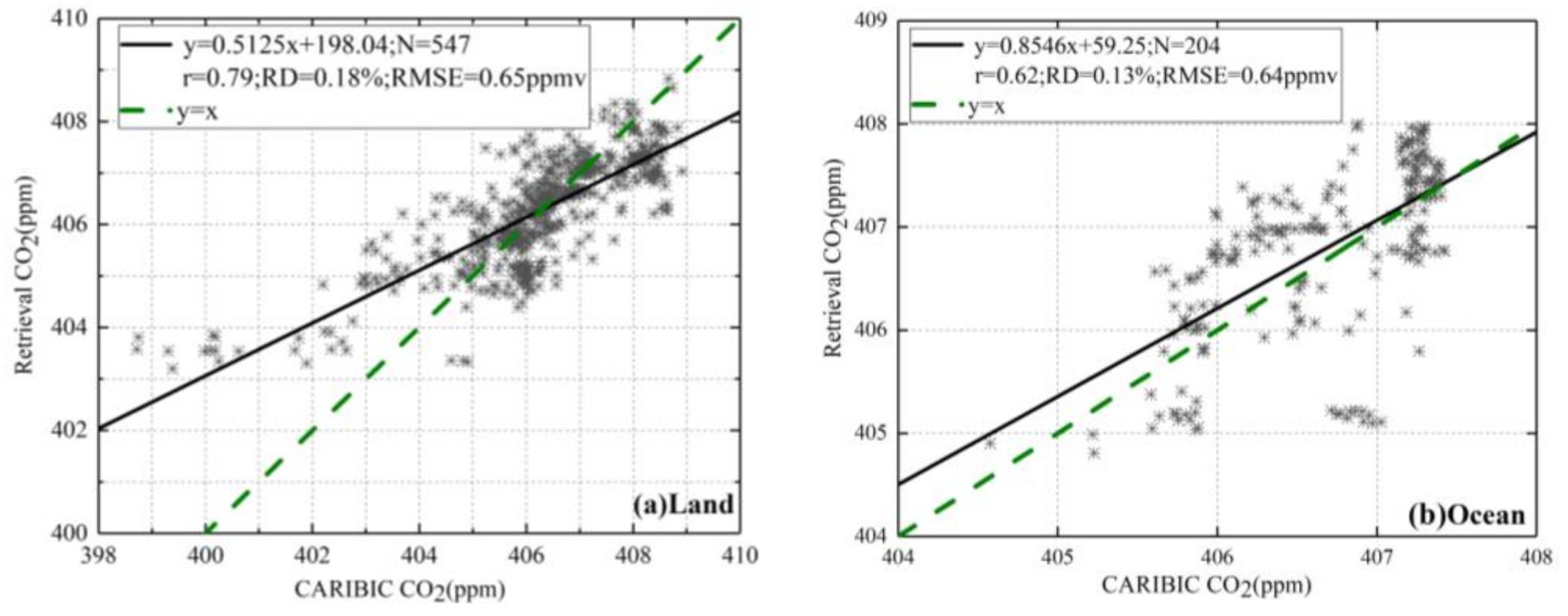
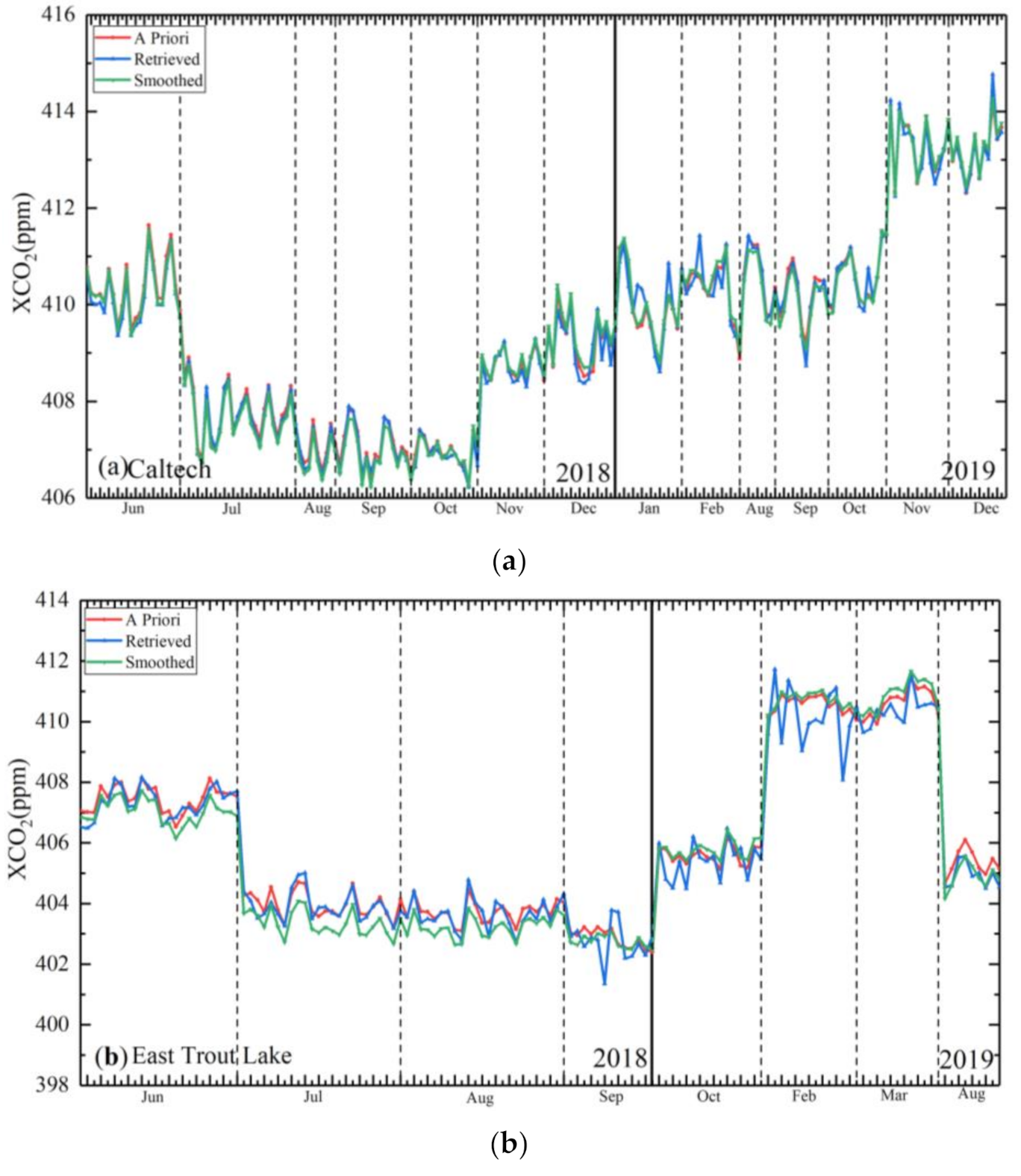
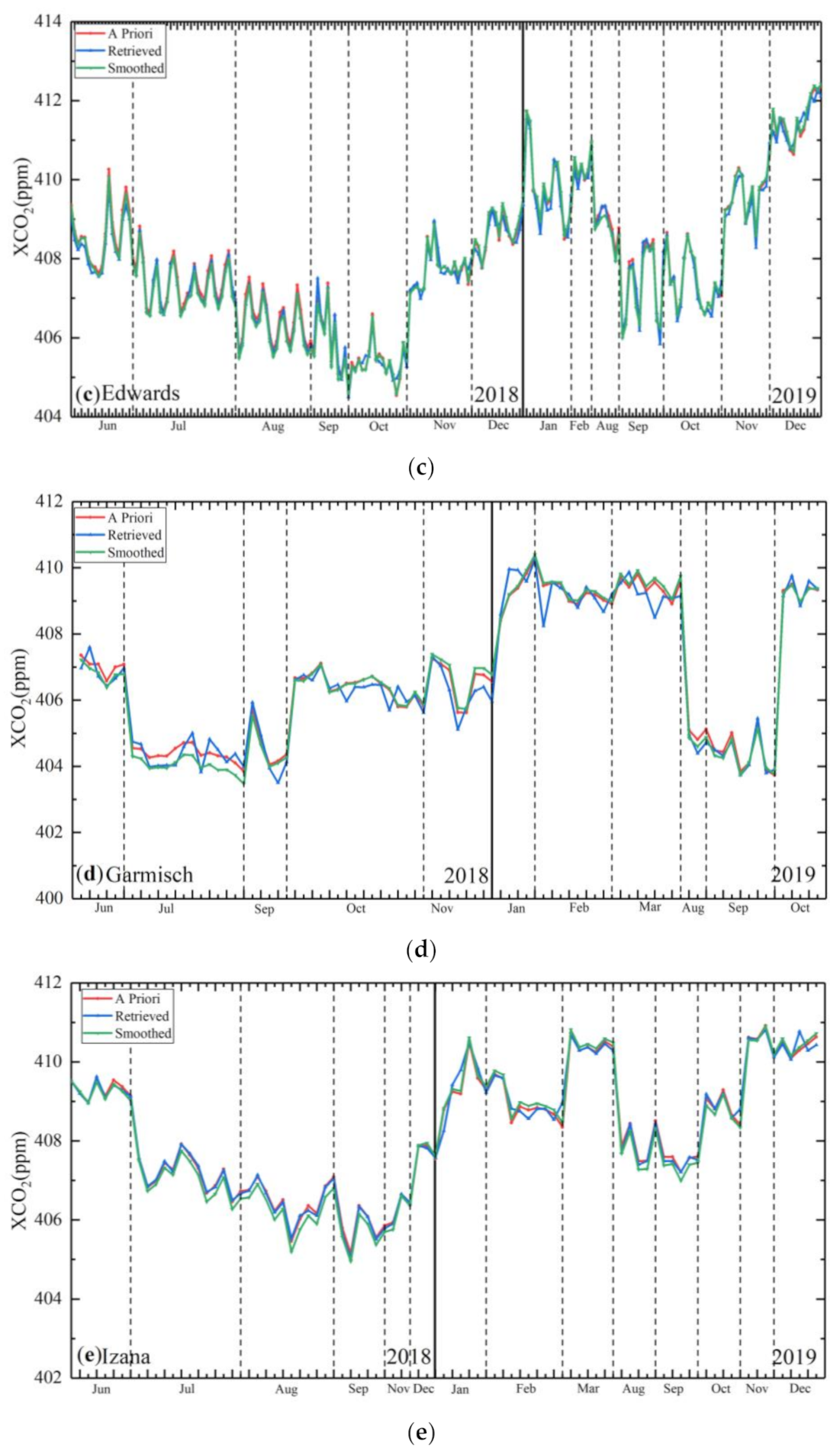

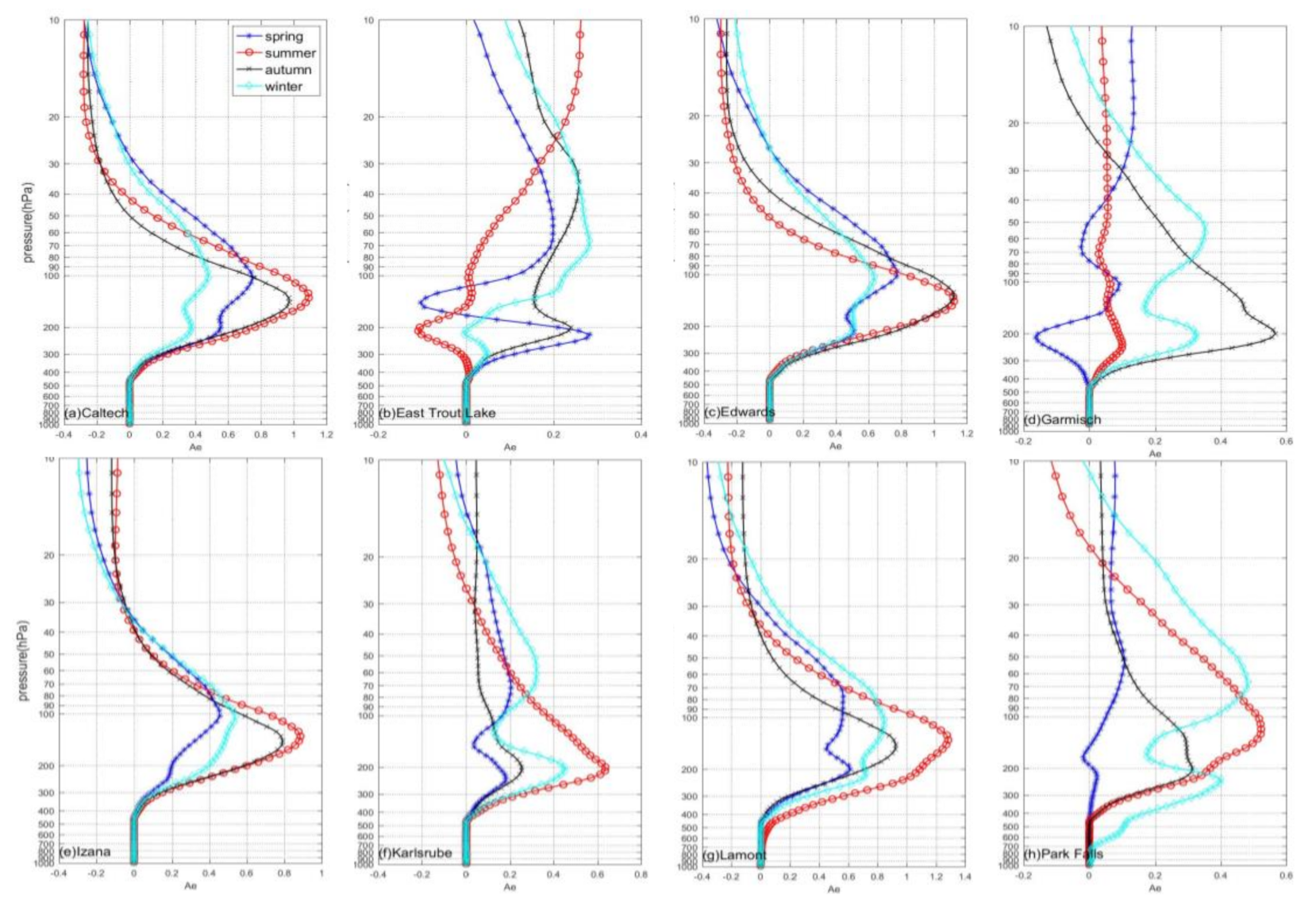

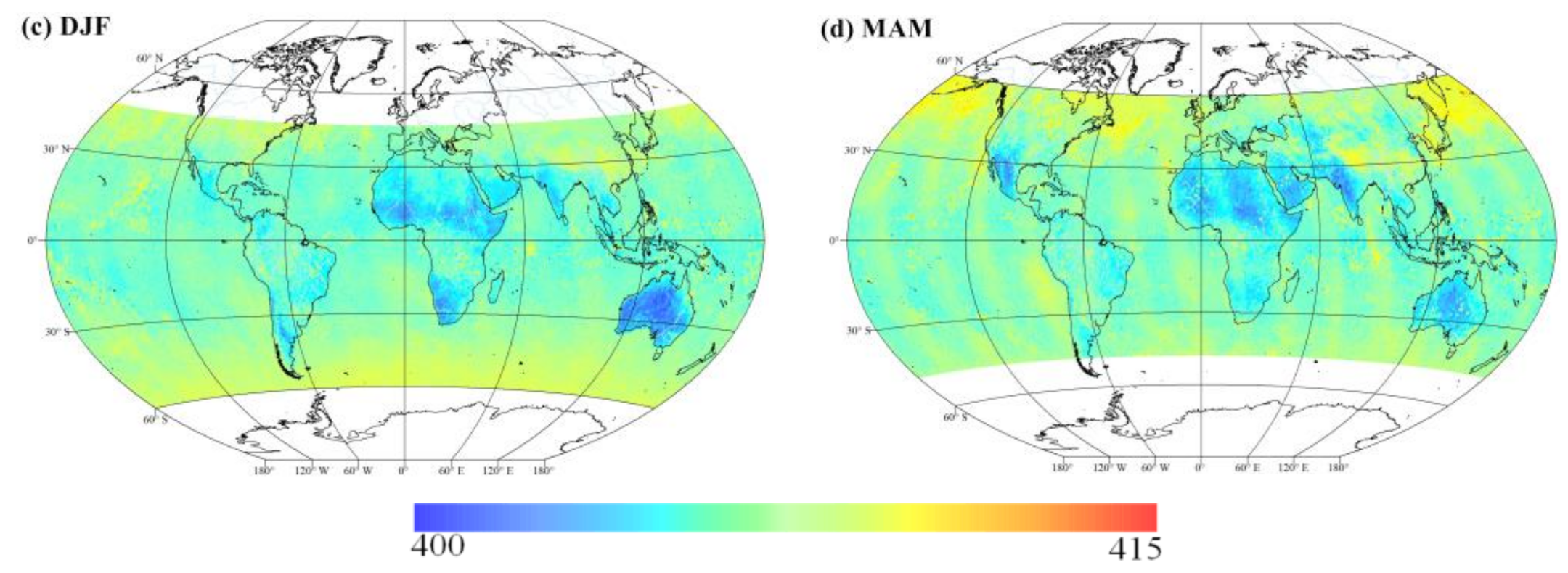

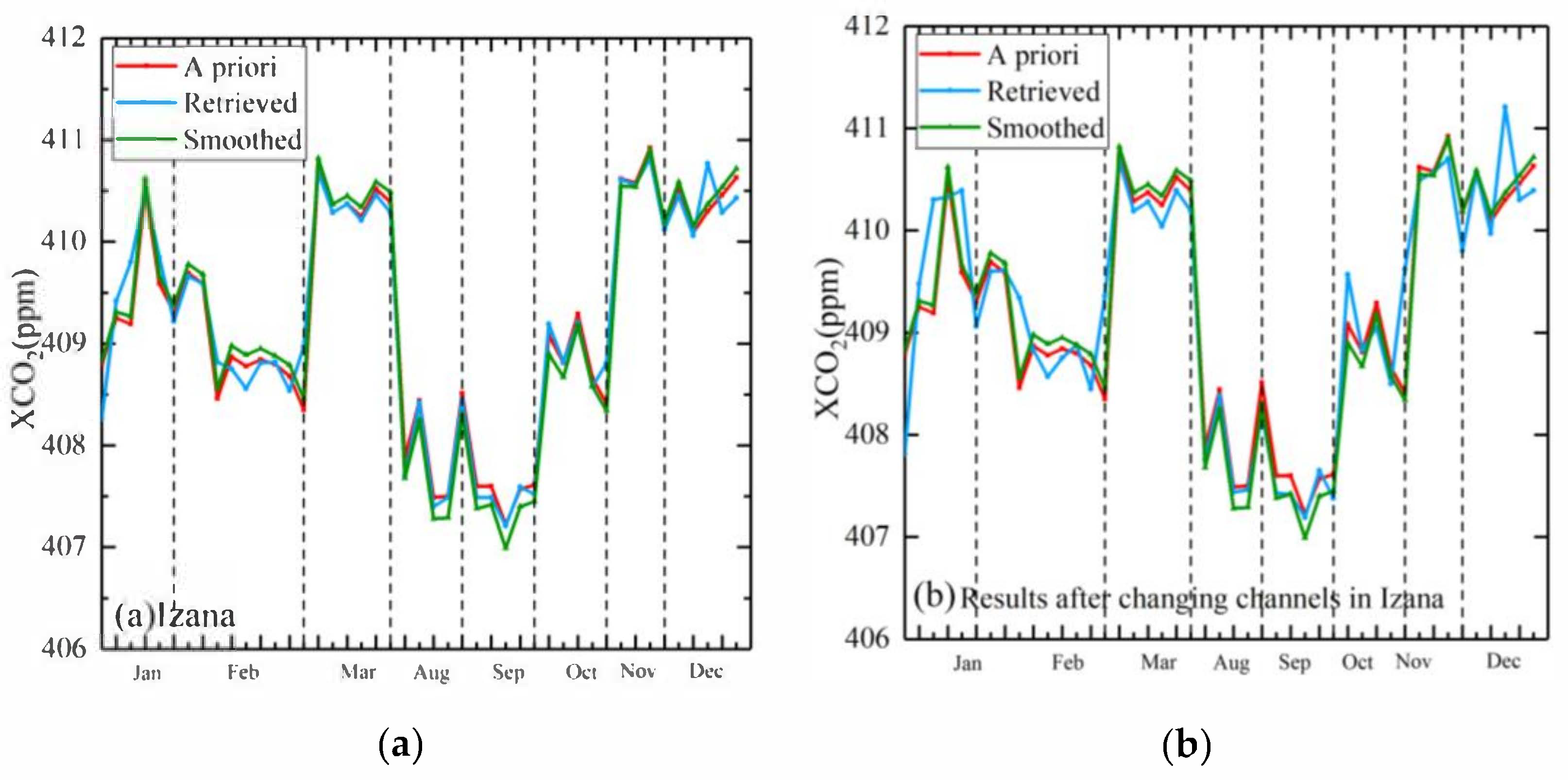
| Sites | Latitude | Longitude | Altitude (km) | Days | Start Date | End Date |
|---|---|---|---|---|---|---|
| Izana (Tenerife, Canary Islands, Spain) [46] | 28.3 | −16.48 | 2.37 | 88 | 5 June 2018 | 19 December 2019 |
| Caltech (USA) [47] | 34.14 | −118.13 | 0.230 | 231 | 5 June 2018 | 31 December 2019 |
| Edwards (USA) [48] | 34.96 | −117.88 | 0.699 | 218 | 5 June 2018 | 31 December 2019 |
| Lamont (USA) [49] | 36.6 | −97.49 | 0.32 | 189 | 5 June 2018 | 31 December 2019 |
| Park Falls (USA) [50] | 45.94 | −90.27 | 0.44 | 194 | 5 June 2018 | 7 December 2019 |
| Garmisch (Germany) [51] | 47.48 | 11.06 | 0.74 | 116 | 5 June 2018 | 18 October 2019 |
| Karlsrube (Germany) [52] | 49.1 | 8.44 | 0.116 | 87 | 9 July 2018 | 30 October 2019 |
| East Trout Lake (Canada) [53] | 54.36 | −104.9900 | 0.5018 | 172 | 5 June 2018 | 30 August 2019 |
| Date | Latitude | RD (%) | RMSE (ppmv) | r | N |
|---|---|---|---|---|---|
| 29 July 2018 | 30° N–90° N | 0.19 | 0.49 | 0.78 | 133 |
| 30° N–60° N | 0.24 | 0.56 | 0.79 | 94 | |
| 60° N–90° N | 0.07 | 0.20 | 0.52 | 39 | |
| 31 July 2018 | 30° N–60° N | 0.23 | 0.62 | 0.86 | 269 |
| 10 October 2018 | 30° N–90° N | 0.08 | 0.41 | 0.70 | 127 |
| 30° N–60° N | 0.09 | 0.44 | 0.71 | 97 | |
| 60° N–90° N | 0.06 | 0.24 | 0.69 | 30 | |
| 11 October 2018 | 30° N–60° N | 0.48 | 0.67 | 0.72 | 281 |
| Scheme. | A Priori (ppmv) | CrIS Retrieved (ppmv) | Smoothing (ppmv) |
|---|---|---|---|
| Caltech (USA) | 409.52 | 409.47 | 409.48 |
| East Trout Lake (Canada) | 406.05 | 405.97 | 405.82 |
| Edwards (USA) | 408 | 407.93 | 407.95 |
| Garmisch (Germany) | 406.71 | 406.65 | 406.65 |
| Izana (Tenerife) | 408.21 | 408.21 | 408.13 |
| Karlsrube (Germany) | 406.44 | 406.29 | 406.31 |
| Lamont (USA) | 408.66 | 408.67 | 408.60 |
| Park Falls (USA) | 407.29 | 407.17 | 407.23 |
| T | H2O | Both Variables | |
|---|---|---|---|
| Spring | 0.041 | 0.0498 | 0.0372 |
| 1.037 | 1.006 | 1.042 | |
| Summer | 0.0165 | −0.0176 | 0.0155 |
| 1.846 | 1.829 | 1.854 | |
| Autumn | −0.002 | −0.021 | −0.006 |
| 2.081 | 2.077 | 2.080 | |
| Winter | −0.016 | 0.013 | −0.013 |
| 1.372 | 1.369 | 1.372 |
Publisher’s Note: MDPI stays neutral with regard to jurisdictional claims in published maps and institutional affiliations. |
© 2021 by the authors. Licensee MDPI, Basel, Switzerland. This article is an open access article distributed under the terms and conditions of the Creative Commons Attribution (CC BY) license (http://creativecommons.org/licenses/by/4.0/).
Share and Cite
Zhang, X.; Zhang, Y.; Bai, L.; Tao, J.; Chen, L.; Zou, M.; Han, Z.; Wang, Z. Retrieval of Carbon Dioxide Using Cross-Track Infrared Sounder (CrIS) on S-NPP. Remote Sens. 2021, 13, 1163. https://doi.org/10.3390/rs13061163
Zhang X, Zhang Y, Bai L, Tao J, Chen L, Zou M, Han Z, Wang Z. Retrieval of Carbon Dioxide Using Cross-Track Infrared Sounder (CrIS) on S-NPP. Remote Sensing. 2021; 13(6):1163. https://doi.org/10.3390/rs13061163
Chicago/Turabian StyleZhang, Xinxin, Ying Zhang, Lu Bai, Jinhua Tao, Liangfu Chen, Mingmin Zou, Zongfu Han, and Zhibao Wang. 2021. "Retrieval of Carbon Dioxide Using Cross-Track Infrared Sounder (CrIS) on S-NPP" Remote Sensing 13, no. 6: 1163. https://doi.org/10.3390/rs13061163
APA StyleZhang, X., Zhang, Y., Bai, L., Tao, J., Chen, L., Zou, M., Han, Z., & Wang, Z. (2021). Retrieval of Carbon Dioxide Using Cross-Track Infrared Sounder (CrIS) on S-NPP. Remote Sensing, 13(6), 1163. https://doi.org/10.3390/rs13061163









